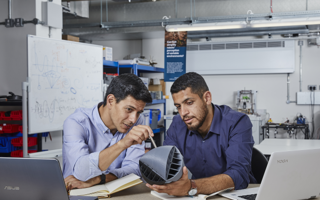News
O-Wind Turbine wins 2018 James Dyson Award
Urban wind turbine claims the prestigious international James Dyson Award

From climate change to poverty, global issues increasingly demand collaborative, cross-cultural responses. Originating from Chile and Kenya, respectively, Nicolas Orellana and Yaseen Noorani represent a new era of talent working together to develop technologies capable of tackling our shared problems. Studying International Innovation MSc together at Lancaster University, they set out to harness urban wind with an inventive new type of turbine. Their design, O-Wind Turbine, has won the 2018 International James Dyson Award.
What’s the problem with wind?
The taller we build our cities, the windier they become. As we hunt for renewable sources of power generation, this powerful and plentiful resource is left untapped largely because traditional wind turbines only capture wind traveling in one direction. This means they are very inefficient in cities where the wind is unpredictable and multi-directional.When wind blows through cities, it becomes trapped between buildings, dragged down to the street, and pushed up into the sky. This catapults wind into chaos, which renders conventional turbines unusable. Using a simple geometric shape, O-Wind Turbine is designed to utilize this powerful, untapped resource, generating energy no matter which way the wind is blowing.
“’Design something that solves a problem’ is an intentionally broad brief," said Sir James Dyson. "It invites talented, young inventors to do more than just identify real problems. It empowers them to use their ingenuity to develop inventive solutions.
O-Wind Turbine does exactly that. It takes the enormous challenge of producing renewable energy and, using geometry, it can harness energy in places where we’ve scarcely been looking – cities. It’s an ingenious concept.”Nicolas Orellana first became interested in the challenge of multidirectional wind after studying NASA’s Mars Tumbleweed Rover. Six feet in diameter, this inflatable ball was designed to autonomously bounce and roll like tumbleweed across Mars’ surface to measure atmospheric conditions and geographical location. Like conventional wind turbines, it was powered by unidirectional wind, which severely impaired the rover’s mobility when faced with obstructions, often throwing it off course and ultimately resulting in the failure of the project.By exploring the limitations of the Tumbleweed, Nicolas’s three-dimensional wind turbine technology was born. Nicolas and his classmate Yaseen Noorani soon identified how cities could use this technology to harness energy to produce electricity.
How does O-Wind Turbine work?
O-Wind Turbine is a 25cm sphere with geometric vents; it sits on a fixed axis and spins when wind hits it from any direction. When wind energy turns the device, gears drive a generator, which converts the power of the wind into electricity. This can either be used as a direct source of power or can be fed into the electricity grid. Nicolas and Yaseen aim for O-Wind Turbine to be installed to large structures, such as the side of a building or on a balcony, where wind speeds are at their highest. Harry Hoster, Director of Energy Lancaster at Lancaster University advised and supported the team in the design process.
He said: “When the two students first approached us about test facilities for a new wind turbine design, we first thought it would just be the 23rd variation of some plain vanilla system. When they humbly showed their video and their prototype, however, we were, excuse the pun, blown away. Only holding it in your hands and playing with it gives you a chance to understand what their new device actually does and how, if things go right, its ability to capture any random breezes will take urban energy harvesting to another level.”
“We hope that O-Wind Turbine will improve the usability and affordability of turbines for people across the world," said creator Nicolas Orellana. "Cities are windy places, but we are currently not harnessing this resource. Our belief is that if we make it easier to generate green energy, people will be encouraged to play a bigger own role in conserving our planet. Winning the international James Dyson Award has validated our concept. The attention we’ve received so far has been humbling and given us the confidence to see the development of this concept as a future career. Already we are in discussions with investors and we hope to secure a deal in the coming months".
